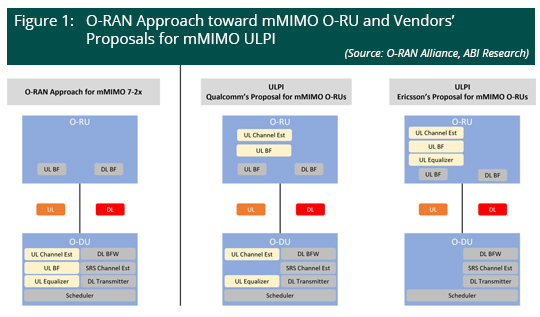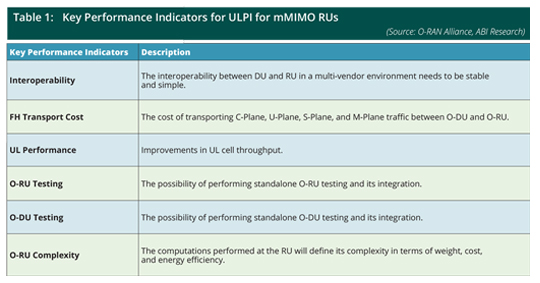A New O-RAN Alliance Work Item on an Open Fronthaul Interface
|
NEWS
|
There is an ongoing debate about the Massive Multiple Output, Multiple Input (mMIMO) optimal split between Distributed Unit (DU) and Radio Unit (RU) functionalities and where lower Physical Layer (PHY) functions should be performed. This is somewhat of a new development, as Option 7.2x has been adopted universally as the most optimal functional split, presenting a compromise between RU processing capabilities and Fronthaul (FH) interface requirements. Nevertheless, the O-RAN Alliance is now discussing a new architecture for mMIMO to improve Uplink (UL) performance and achieve stable interoperability with reduced FH transport cost. This follows a recent conclusion that Option 7.2x is not optimal for large-scale, high-end mMIMO configurations, when this split leads to significant performance degradation. Ericsson, Nokia, and Qualcomm claim to have performed network simulations that illustrate this effect.
A new Work Item (WI) called Uplink Performance Improvement (ULPI) was initiated to enhance the existing 7-2x Open Fronthaul (O-FH) interface and a specification related to this topic is scheduled by the end of 2023. To facilitate this requirement, several proposals were submitted by different companies, but only two proposals were selected for further developments. The two proposals are from Ericsson based on integrated UL receiver architecture and by Qualcomm based on split UL receiver architecture. Ericsson, Nokia, AMD, and ZTE agreed on a joint contribution that supports Ericsson’s proposal with the equalizer—an important element in radio design—residing at the RU. Meanwhile, Qualcomm’s proposal has been supported by Orange, DT, Samsung, and AT&T.
Proposals for New Architecture from Key Vendors, Which One is Best or Are They Equal?
|
IMPACT
|
O-RAN Initial Approach: In order to facilitate the requirement of keeping the RU as simple as possible and to reduce the FH interface transport cost, the O-RAN Alliance has proposed a single-split Option 7-2x that allows two different variations:
- Non-mMIMO: RUs up to 8T8R, classified as Lower-Layer Split (O-LLS) that enables achieving optimal radio performance with limited RU complexity and without the need of beamforming information over the interface for interoperability.
- mMIMO: RU above 8T8R, classified as O-LLS that may limit the radio performance and have limited RU complexity, but interoperability becomes more complex due to the exchange of beamforming information over the FH interface.
To overcome the problem related to mMIMO O-RUs, the proposals from two major contributors were considered to improve the UL performance of mMIMO RUs as shown in Figure 1.
- Ericsson’s Proposal for mMIMO-RUs: Ericsson has proposed an alternative Next Gen Open Lower Layer Split (NG-OLLS) solution for mMIMO RUs to improve the CAT-B mMIMO UL performance. Ericsson believes that, considering the Research & Development (R&D) cost, vendors will converge with ULPI as an alternative solution for mMIMO O-RUs. As illustrated in Figure 1, the idea is to move functions from DU to RU, including UL channel estimation, UL beamforming, and the UL equalizer. This idea has been supported by Nokia, ZTE, AMD, Intel, Vodafone, and NTT DOCOMO.
- Qualcomm’s Proposal for mMIMO O-RUs: Qualcomm also proposed a solution for mMIMO RUs, in which the UL equalizer is hosted at the O-DU, whereas UL channel estimation and UL beamforming calculations are being performed at the O-RU as shown in Figure 1. This idea has been supported by Orange, DT, Samsung, and AT&T.

Table 1 illustrates performance indicators that both proposals are attempting to fulfill, but neither can address all areas in a perfect manner. Ongoing discussions within the O-RAN Alliance will conclude which one will prevail, but technical merit may not be the only decision factor, especially when multiple companies and interests are involved.

A Balanced, Trade-off Approach toward mMIMO RUs and Its Standardization
|
RECOMMENDATIONS
|
The industry has discussed this new development publicly and several insiders argue that these new FH interface developments are a delaying tactic, executed by the incumbent vendors to derail the Open Radio Access Network (RAN) ecosystem and its development. However, based on technical discussions the ABI Research team has had with multiple stakeholders, it appears as if the Option 7.2x split will indeed result in performance degradation, if large-scale, dense, and high-end mMIMO deployments are considered. It remains to be seen whether this new interface will be backward compatible with the existing 7.2x split, but Open RAN supporters do have a valid claim that this new development may delay deployments, because several mobile operators may choose to wait for discussions to wrap up and the new functional split to be fully specified. Nevertheless, according to the vast majority of the industry, this new interface will be necessary for mMIMO Open RAN to mature and proceed. It may also mean that incumbent vendors will support it, increasing competition in the Open RAN domain, giving mobile operators more choice for their deployments. Regardless of this development, there are still several technical concerns.
RU Complexity, Energy Efficiency, and Standardization Concerns: Considering the fact that RU is the most power-consuming component in the radio network, one can argue that hosting more functionalities at the RU will make it more computationally complex, heavier, and energy inefficient. But the question here is to find the right trade-off between mMIMO UL performance, FH transport cost, and the complexity of mMIMO RUs. Moreover, there are other ongoing issues related to latency, interoperability, testing, and overall integration of O-RAN components that may further delay developments related to mMIMO RUs. Therefore, the question is, if compromising RU complexity for the sake of improved UL mMIMO performance, will transport cost and stable interoperability still bring more benefits at the cost of a more complex RU? Or will it result in putting more burden on RUs with minimal gains and further delays in O-RAN development? It will be interesting to see how industry will achieve the Key Performance Indicators (KPIs) mentioned in Table 1 to measure the performance of mMIMO RUs. Moreover, it is highly important to reach agreement on a single approach and standardize the new architecture for mMIMO RUs to avoid unbalanced and incompatible development of the technology. It is crucial that both the O-RAN Alliance contributors, including vendors, operators, and research institutions, follow a holistic approach toward solving this problem and fully collaborate on developing and testing the overall Open RAN architecture.

